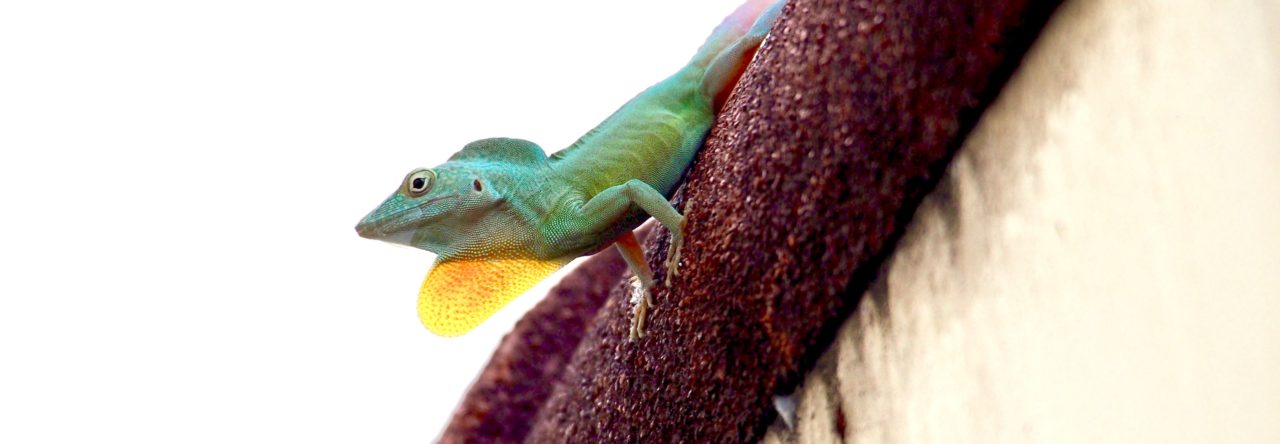
“Squamates Playing Poker” – a clever depiction of sex chromosome evolution (image by Anna Minkina shared with permission from Tony Gamble; read more about the image on the Gamble lab website)
Anole Annals contributor Yann Bourgeois reports on the talk by Tony Gamble on sex chromosome evolution. While this talk wasn’t specifically about anoles, our favorite lizards are no stranger to this topic, as discussed previously here on Anole Annals. Gamble builds on his previous work in an impressive analysis of sex chromosome evolution across squamates and snakes. We can look past the anoles taking the back-seat on this one because the talk was fascinating and sure to be of interest to readers here. Yann Bourgeois reports:
How sex chromosomes originate is one of the most intriguing questions of evolutionary biology. It is also a complex one, as the mechanisms that lead to their formation are not clearly understood and our knowledge is mostly based on model species that are not necessarily representative (most of them have strongly heteromorphic sex chromosomes). It is generally thought that sex chromosomes emerge as new alleles at a sex-determining gene stop recombining with each other. Since sex-ratio has to reach an equilibrium, balancing selection maintains the two alleles at high frequencies, and strong linkage locks together loci involved in reproductive isolation and mating. As the two non-recombining blocks diverge they accumulate mutations that can be used to discriminate them using molecular tools. In the most extreme case, one of the two chromosomes degenerates, such as the Y chromosome in humans.
Most sex-determining systems fall into two categories: ZW systems where the male is homozygous ZZ and females are heterozygous, and the classical XY system with XY males and XX females. We know from previous research that anoles fall into the XX/XY category (although some species are XXXX/XXY). However, in general in squamates and snakes in particular, the evolution of sex-chromosomes is poorly known. Early studies mostly focused on heteromorphic chromosomes, which are so divergent that they can easily be identified through cytogenetics. But heteromorphic sex chromosomes like those in anoles and other squamates are not necessarily visible, and other tools are needed to identify which system occurs in a given species.
In his talk, Gamble showed how to use RAD-seq or RNA-seq to identify loci associated with sex, and to discriminate between XY and ZW systems (for more information on this approach, check out his 2015 paper in Molecular Biology and Evolution). For example, in an XX system, all males will be heterozygous at sex-linked loci while all females will be homozygous at the same sites. Depth of coverage will also be twice as low at X-linked loci for males than for females as they harbor a single X chromosome. Using this set of molecular methods, Tony demonstrates that there is a high turn-over of sex-determining systems in squamates and snakes, with more than 40 transitions between ZW and XY, half of those transitions being found in geckos.
It is also possible to map those sex-associated loci to reference genomes to identify syntenic blocks that may be repeatedly recruited during sex-chromosome evolution. For example, in the crested gecko (Correlophus ciliatus), most sex-associated loci map on chicken’s chromosome 10. Some genes may have a higher likelihood to be recruited when a new sex chromosome appears, but whether this can be extended to specific syntenic blocks remains an open question. This is made even more difficult by the fact that sex-determining genes in squamates are not yet known with certainty. This ongoing work on macro-evolutionary dynamics of sex chromosomes will provide interesting findings that may be linked to the evolution of mating strategies and speciation in anoles.
- Puerto Rico Herpetology Symposium - September 21, 2023
- Anole Symposium This Fall? - July 14, 2023
- Parallel Urban Adaptation from Phenotype to Genotype in Anolis Lizards - January 20, 2023


Leave a Reply